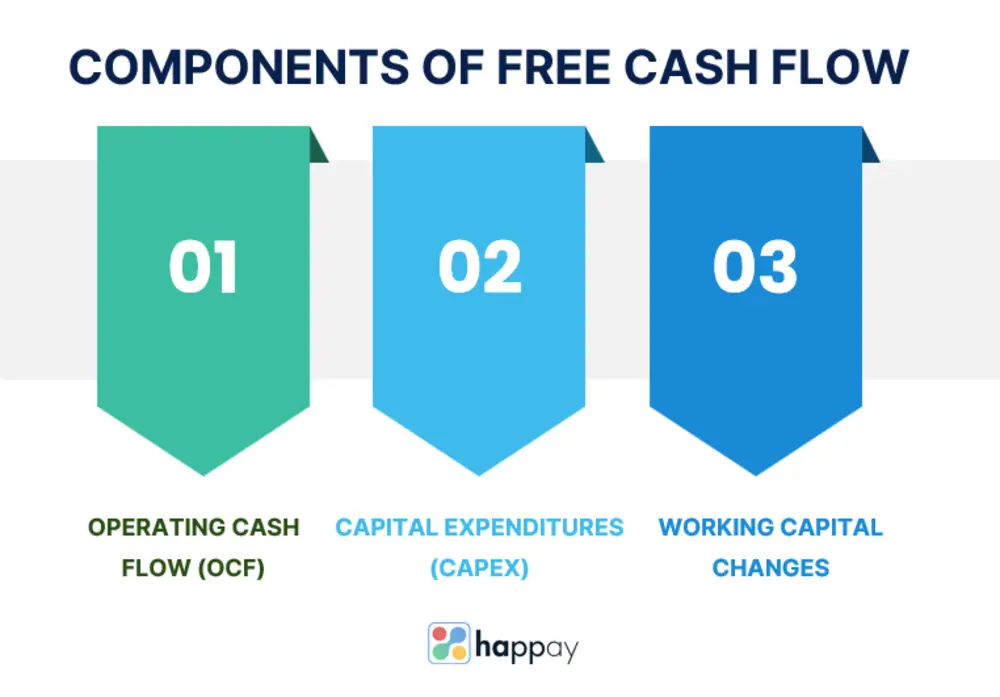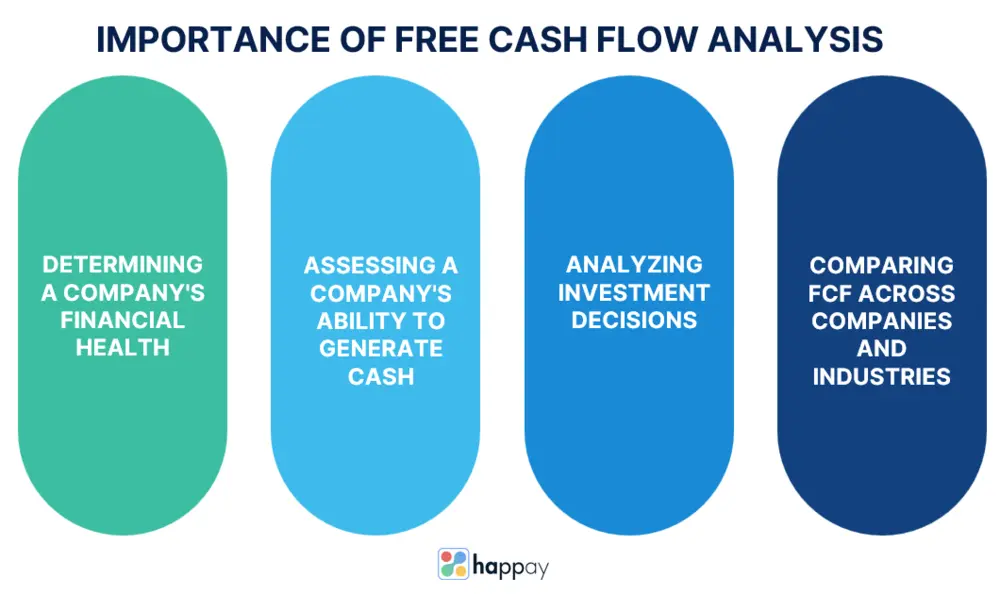Last Updated on November 28, 2025
Introduction
Free cash flow is one of the most fundamental metrics in numerous distinctive concepts in Finance. It provides insights into your company’s financial health and operational efficiency. Understanding the concept of free cash flow is crucial if you want to make informed decisions and navigate the complexities of corporate finance.
Our guide will help you understand and break the concept into various facets. Besides its definition and calculation, we will also help you understand its significance in investment analysis and strategic decision-making.
What is free cash flow (FCF)?
Free cash flow (FCF) is a crucial financial metric. It measures the amount of cash your company generates after accounting for necessary capital expenditures and working capital requirements. In simpler terms, it represents the cash available to your company that can be used for reinvesting in the business or paying off debts. You can even consider distributing dividends to shareholders and pursuing new growth opportunities.
Let’s consider an example to illustrate this concept.
Suppose Company ABC reported a net cash flow from operating activities of INR 1,00,00,000 during the year. Additionally, they invested INR 50,00,000 in new machinery and had INR 20,00,000 tied up in working capital requirements.
We subtract the capital expenditures and working capital requirements from the net cash flow from operating activities to calculate Company ABC’s FCF.
FCF = 1,00,00,000 (Net Cash Flow) – 50,00,000 (Capital Expenditures) – 20,00,000 (Working Capital) = 30,00,000.
Company ABC has 30,00,000 FCF available for its business activities in this scenario.
Must Read: CapEx vs. OpEx: A Guide to Understanding the Differences
What is the importance of free cash flow (FCF) in financial analysis?
Free cash flow is one of the most critical metrics for evaluating the health and performance of your company. Some financial accounting figures may have a limited perspective. However, FCF offers a holistic view of your company’s ability to generate cash and its financial flexibility.
Here are some key reasons why FCF is critical in financial analysis:
1. An accurate measure of cash generation
Accounting practices and non-cash items can influence your company’s profitability. However, FCF focuses solely on cash. It represents the actual cash available after covering operational expenses and investments.
2. Evaluating financial health
Positive free cash flow indicates that your company’s core operations generate more cash than they consume. It suggests financial stability and the capacity to weather economic downturns.
3. Investment and growth potential
If your company has robust FCF, it can develop and expand its market presence. Your company can also consider acquiring new businesses or undertaking innovative projects. FCF is thus a reliable indicator of your company’s growth prospects.
4. Debt management and solvency
For companies with debt obligations, FCF is pivotal in determining their ability to service and repay debts. A healthy FCF allows your company to manage its debt load effectively and reduce the risk of financial distress.
5. Shareholder value and dividends
FCF helps support dividend payments and share buybacks. Companies with consistent positive FCF can reward their shareholders while maintaining a solid financial position.
6. Comparing companies across industries
FCF enables meaningful comparisons between companies operating across industries and with varying capital structures. It is a standard metric to assess financial performance across sectors.
7. Forecasting and valuation
Analysts and investors often use FCF projections to estimate a company’s intrinsic value. Discounting future FCF helps them determine the present value of a company for improved investment decision-making.
8. Identifying red flags
Negative or declining FCF can indicate underlying issues within a company. These include inefficient operations, excessive spending, or aggressive accounting practices. The insight can prompt further investigation before making investment or partnership decisions.
Quick Read: How to Prepare a Cash Flow Statement Using the Indirect Method?
The components of free cash flow
Understanding the components of FCF is essential to grasp the concept entirely. Let’s look at the three primary elements in detail.

1. Operating Cash Flow (OCF)
Operating cash flow is also known as cash flow from operations. It is the foundation of FCF and represents the cash generated or consumed from a company’s core business activities. OCF includes money received from customers for goods or services. It also comprises cash paid for operating expenses, like wages and utilities.
Additionally, it considers non-cash items like depreciation and changes in working capital. A positive OCF indicates a company’s operations generate cash, while a negative one suggests that processes consume money.
2. Capital Expenditures (Capex)
Capital expenditures are the cash spent on investments in long-term and fixed assets. These include machinery, equipment, buildings, and infrastructure. Capex reflects the company’s commitment to enhancing its productive capacity and supporting future growth.
These expenditures are crucial for maintaining and expanding your company’s operations. However, they represent cash outflows in the short term. To determine FCF, subtract capex from operating cash flow. This is because capex means cash is no longer available to the company for other uses.
3. Working capital changes
Working capital changes are crucial in determining your company’s cash position. It represents the net change in your company’s short-term assets and current liabilities. Besides accounts receivable, it also considers accounts payable and inventory. When calculating FCF, changes in working capital are factored into the equation to provide a more accurate representation of cash flows from operating activities.
A positive change in working capital indicates that the company uses less cash to fund its operations. On the other hand, a negative change suggests an increase in cash tied up in day-to-day activities. Monitoring working capital changes is vital as it directly impacts your company’s ability to meet short-term obligations and maintain financial stability.
Quick Read: 10 Best Accounts Payable (AP) Software
Concepts of free cash flow and its significance
Here are the critical concepts of FCF and why it matters:
1. Cash generation and usability
FCF represents the cash your company generates from its operations that is available for various uses. It is the surplus cash after covering expenses, like capital expenditures and working capital requirements. The money helps with growth initiatives, debt reduction, dividends, share buybacks, and other strategic investments. FCF provides insights into your company’s cash-generating capability and capacity to create value for stakeholders.
2. Operating efficiency and profitability
Isolating cash flows from core operations helps FCF offer a clearer picture of your company’s operating profit. While non-cash items and accruals can influence accounting profits, FCF focuses solely on cash. It is thus a more reliable indicator of operating efficiency. A positive FCF shows that the company generates enough money to cover expenses and investments. It indicates a sustainable business model.
3. Investment analysis and valuation
FCF serves as a vital tool for company analysis for investors. It helps determine your company’s intrinsic value by estimating its ability to generate cash flows in the future. Discounting projected FCF also helps analysts arrive at the present value of your company. It helps in investment decision-making and identifying potentially undervalued or overvalued stocks.
4. Financial health and flexibility
FCF provides a measure of your company’s financial health and flexibility. Positive FCF indicates that your company can overcome economic downturns and service its debts. Conversely, negative or declining FCF may raise concerns about your company’s financial sustainability.
5. Comparative analysis
FCF facilitates meaningful comparisons between companies operating in different industries or with varying capital structures. It acts as a standardized metric to enable analysts to assess the financial performance of companies across sectors.
6. Operational decision-making
Understanding FCF helps make strategic decisions. It provides insights into the best allocation of resources. These include investing in new projects, paying off debts, repurchasing shares, or increasing dividends. FCF analysis helps optimize resource allocation to maximize shareholder value.
Quick Read: Cash Flow Forecasting: What is it, Components, Methods, Process & Formats
How to calculate free cash flow?
Calculating FCF is a straightforward process that requires critical financial data from your company’s statement of cash flows and balance sheets. The free cash flow formula is as follows.
FCF= Operating Cash Flow (OCF) – Capital Expenditures (Capex)

also helps determine if there are underlying issues that require further investigation. Industry-specific factors and capital-intensive sectors may influence FCF levels. Industry comparisons are thus relevant for a comprehensive analysis.
Here’s a step-by-step process to calculate FCF.
- STEP 1: Determine operating cash flow
You can find operating cash flow on the cash flow statement in the “operating activities” section. To calculate OCF, add non-cash expenses like depreciation and amortization to the net income and adjust for changes in net working capital items. These include accounts receivable, accounts payable, and inventory.
- STEP 2: Calculate capex
Capex includes cash spent on long-term assets, like equipment and property. The information required to calculate capex is available in the company’s income statements. Look at the “investing activities” section of the cash flow statement or the balance sheet.
- STEP 3: Subtract capex from OCF
After obtaining OCF and Capex, subtract the latter from the former to arrive at FCF. The resulting value indicates the net cash available to the firm after accounting for investments in long-term assets.
Now that we know how to calculate FCF, interpreting it is crucial. Let’s understand how to analyze FCF.
How to analyze free cash flow?
1. Positive and negative FCF: What they mean:
A positive FCF suggests that your company’s operating activities generate more cash than they consume. It is generally a positive sign, indicating the company’s ability to fund investments and pursue growth opportunities without resorting to external financing.
Conversely, a negative FCF indicates your company’s operating cash flow is insufficient to cover its capital expenditures. Occasional negative FCF can come up during periods of heavy investment. However, persistent negative FCF can raise concerns about the company’s finances and ability to meet financial obligations without relying on external funding.
2. Evaluating FCF in relation to industry benchmarks
Assessing a company’s FCF based on industry benchmarks is essential for contextual interpretation. Comparing FCF with competitors or industry averages helps determine whether the company’s cash generation aligns with its peers.
It also helps determine if there are underlying issues that require further investigation. Industry-specific factors and capital-intensive sectors may influence FCF levels. Industry comparisons are thus relevant for a comprehensive analysis.
Learn About: Cash Flow Problems- 4 Best Ways to Solve It
Free cash flow calculation example
Let’s consider an example of ABC Corporation to illustrate the calculation of FCF. ABC Corporation reports the following financial data:
Net income: INR 20,00,000
Depreciation and amortization: INR 5,00,000
Changes in Working Capital: INR 3,00,000 (increase)
Capital Expenditures (Capex): INR 8,00,000
STEP 1: Calculate operating cash flow
OCF = net income + depreciation and amortization + changes in working capital
OCF = 20,00,000 + 5,00,000 + 3,00,000 = 28,00,000
STEP 2: Calculate capex
Capex = 8,00,000
STEP 3: Calculate FCF
FCF = OCF – Capex
FCF = 28,00,000 – 8,00,000 = 20, 00,000
In this example, ABC Corporation’s FCF is INR 20,00,000. It indicates the company generated a positive cash surplus after accounting for capital expenditures.
Importance of free cash flow analysis
Let’s look at the different reasons why FCF analysis is crucial.

1. Determining your company’s financial health
After accounting for necessary investments, FCF analysis provides a transparent view of your company’s ability to generate cash from its core operations. A positive FCF indicates that the company is generating surplus cash. It can help with growth, debt reduction, and rewarding shareholders.
On the other hand, negative FCF suggests that the company’s cash flow is insufficient to cover its capital expenditures. It raises concerns about the company’s financial sustainability and liquidity. Evaluating FCF enables business professionals to gauge the financial stability of your company. They can identify potential cash flow challenges and address them proactively.
2. Assessing your company’s ability to generate cash
Cash flow is the lifeblood of any business. FCF analysis plays a pivotal role in determining your company’s ability to generate cash consistently. While accounting profits may be inaccurate due to non-cash items, FCF focuses solely on cash flows from operations. It gives an accurate measure of your company’s cash-generating capability.
A company with a positive FCF demonstrates operational efficiency and the capacity to maintain its financial strength even during challenging conditions. Understanding a company’s cash generation potential through FCF analysis helps investors and lenders make informed decisions about the company’s creditworthiness.
3. Analyzing investment decisions
FCF analysis is invaluable when making investment decisions. Investors often use FCF to estimate a company’s intrinsic value and determine whether the current stock price is undervalued or overvalued. Discounting projected FCF helps investors arrive at the present value of a company. They get a more accurate assessment of its investment potential.
Positive FCF indicates that a company generates enough cash to support growth initiatives or distribute dividends. It may attract investors looking for profitable investment opportunities. Conversely, negative or declining FCF may raise concerns among investors and prompt further investigation before committing to an investment.
4. Comparing FCF across companies and industries
FCF is a standardized metric providing a level playing field for financial analysis. Investors and analysts can use FCF to evaluate companies within the same industry and identify leaders in cash generation and operational efficiency.
Comparing FCF across industries allows stakeholders to gain insights into sector-specific trends and assess how different companies manage their cash flow dynamics. Benchmarking FCF against industry averages helps investors identify potential outperformers or underperformers. They can make more informed investment decisions.
Read More: Cash Flow Analysis: What is it, Methods, Objectives, How does it Work, Example & Key Metrics
Advantages of free cash flow
Let’s explore some of the critical advantages of using FCF in financial assessment:
1. Holistic financial picture
Traditional accounting metrics may not capture the actual cash position of your company. However, FCF provides a comprehensive view of your company’s financial health. It considers operating performance and capital expenditure to give stakeholders a clearer picture of the company’s cash generation and usability.
2. Cash focus
FCF focuses solely on cash flows. It eliminates the distortions caused by non-cash accounting entries. The emphasis on cash is crucial, reflecting the actual money available to the company. It allows for more accurate assessments of liquidity and solvency.
3. Future performance estimation
Projecting future FCF based on historical data and growth assumptions helps analysts estimate a company’s potential cash flow and financial health. The forecasting ability aids in making informed investment decisions and strategic planning.
4. Flexibility and decision-making
Positive FCF empowers companies with financial flexibility. It provides the capacity to invest in growth opportunities and undertake mergers and acquisitions. They can also pay off debts or return value to shareholders through dividends or buybacks. The flexibility enhances decision-making and positions the company for sustainable growth.
5. Investor attractiveness
Companies with consistent positive FCF are often perceived as attractive investment options. Investors seek companies that generate surplus cash, as it signals a stable business model with the potential for long-term returns.
6. Creditworthiness and borrowing capacity
Lenders and creditors consider FCF when evaluating a company’s creditworthiness. Positive FCF indicates a company’s ability to meet its financial obligations and enhances its borrowing capacity. It also improves access to capital at favorable terms.
7. Benchmarking and industry analysis
FCF is a standard metric for comparing companies within the same industry and across sectors. It facilitates benchmarking and industry analysis. Stakeholders can identify industry leaders in cash generation and operational efficiency.
8. Early warning system
Negative or declining FCF can act as an early warning system for potential financial distress. Consistent negative FCF may indicate underlying issues within the company’s operations. Management must take corrective measures before the situation worsens.
9. Long-term value creation
FCF emphasizes sustainable cash generation to foster long-term value creation rather than short-term accounting profits. It encourages companies to make sound investment decisions, contributing to their continued growth.
Suggested Read: Financial Statement: Definition, Objectives, Types, Advantages & Tools
Disadvantages of free cash flow
FCF analysis offers numerous advantages. However, it is essential to know its potential disadvantages to make informed decisions. Here are some drawbacks to consider when using FCF.
1. Capital intensive industries
FCF may be a better metric for capital-intensive industries like manufacturing or infrastructure. These industries require significant capital expenditures necessary for growth and operational maintenance. In such cases, negative FCF might be a common occurrence during periods of heavy investment. It can lead to misinterpretation of a company’s financial health.
2. Short-term focus
Short-term cash flow fluctuations might not accurately reflect the company’s long-term potential. It is essential to consider FCF trends over multiple periods to gauge the company’s sustainable cash generation capabilities.
3. Subject to manipulation
Just like any financial metric, FCF is not immune to manipulation. Companies might use accounting techniques to influence FCF figures or strategically time their capital expenditures to present a more favorable financial image. It underscores the importance of conducting thorough due diligence and cross-referencing FCF with other economic indicators.
4. Working capital management
FCF includes changes in working capital. Various factors can influence them, including shifts in customer payment terms and inventory management policies. Such fluctuations in operating capital might not accurately reflect the company’s operational efficiency.
5. Lack of standardization
Different companies and industries have varying practices for calculating and presenting FCF. A lack of standardization can make cross-company or cross-industry comparisons challenging. It will require additional efforts to ensure consistency.
6. Limited short-term focus
Companies might prioritize short-term FCF goals, like reducing capital expenditures. It could hinder long-term growth and innovation. Focusing solely on immediate cash flow optimization might lead to missed opportunities for future value creation.
7. Quality of earnings
FCF does not consider the quality of a company’s earnings or its ability to sustain profitability. A company with a positive FCF might still have declining revenues or face competitive threats. Complementing FCF analysis with a comprehensive evaluation of the company’s financial performance is essential.
Also, Read: Capital Investment: Meaning, Types, How it Works & Examples
Examples and real-world applications of free cash flow
FCF is a versatile financial metric with various real-world applications across business contexts. Let’s explore some examples of how FCF applies in practice.
1. Investment analysis
Investors use FCF as a fundamental tool for evaluating potential investment opportunities. Analyzing a company’s FCF helps them assess its cash generation capabilities and long-term value potential. Positive FCF signals a company’s ability to invest in growth initiatives and pay dividends, making it an attractive investment prospect.
2. Valuation and stock analysis
Financial analysts and equity researchers incorporate FCF analysis in valuing stocks and determining their intrinsic worth. Discounted cash flow (DCF) analysis, a popular valuation method, utilizes projected future FCF to estimate the present value of a company. The technique helps make informed investment decisions and identify undervalued or overvalued stocks.
3. Credit analysis and lending decisions
Lenders and creditors use FCF to assess a company’s creditworthiness and repayment capacity. A company with a positive and growing FCF is less risky, making it more likely to receive favorable borrowing terms and access to capital.
4. Merger and acquisition (M&A) evaluation
In M&A transactions, FCF analysis helps evaluate the target company’s financial viability. Acquirers assess the target’s FCF to determine its cash generation potential and ensure the acquisition aligns with its growth objectives.
5. Capital budgeting and resource allocation
FCF analysis helps management make strategic decisions regarding capital budgeting and resource allocation. Understanding the company’s cash-generating capabilities helps executives prioritize investments that align with the company’s long-term growth strategy.
6. Dividend policy and shareholder returns
Companies with positive and sustainable FCFs are likelier to implement dividend policies and share buybacks. FCF analysis enables management to determine the appropriate level of dividends and allocate surplus cash for rewarding shareholders.
7. Operational efficiency and performance evaluation
Comparing FCF across different periods allows management to assess the company’s operational efficiency and financial performance. Consistently positive FCF indicates effective cash management and revenue generation. On the other hand, negative or declining FCF might signal inefficiencies that require corrective action.
8. Forecasting and financial planning
FCF projections help in financial planning and forecasting. Estimating future cash flows based on historical performance and growth expectations helps companies develop realistic budgets and set achievable financial goals.
Quick Read: Cash Flow Forecasting: What is it, Components, Methods, Process & Formats
Free cash flow vs. net cash flow
Here’s how free cash and net cash flow differ from each other.
Aspect |
Free Cash Flow |
Net Cash Flow |
|
Definition |
Represents the cash available after accounting for capital expenditures and working capital changes. It measures the cash generated from operations that can help with investments and debt reduction. |
Refers to the total cash inflows and outflows during a specific period, including operating, investing, and financing activities. It reflects the overall change in cash position for the period. |
|
Focus |
Emphasizes cash generated from core business activities after accounting for necessary investments. |
Considers all cash inflows and outflows from operating, investing, and financing activities. It provides a comprehensive view of cash movement. |
|
Purpose |
Evaluates a company’s cash-generating capability and financial health. It focuses on the surplus cash available for growth and shareholder value. |
Provides a holistic view of a company’s cash position and cash flow activities, including investing and financing activities. These may not directly reflect the company’s operational performance. |
|
Calculation |
FCF = Operating Cash Flow – Capital Expenditures |
Net Cash Flow = Total Cash Inflows – Total Cash Outflows |
|
Components |
Operating cash flow (OCF), capital expenditures (Capex), and working capital changes. |
Operating cash inflows and outflows, investing cash inflows and outflows, and financing cash inflows and outflows. |
|
Long-term sustainability |
Focuses on the company’s capacity to generate sustainable cash flows over time. It accounts for reinvestment needs and working capital requirements. |
May include one-time or non-recurring cash flows that do not reflect the company’s ongoing operational performance or cash-generating capability. |
|
Usefulness in analysis |
Valuable for investment analysis, financial planning, and assessing a company’s ability to create shareholder value. |
Provides a comprehensive view of a company’s overall cash flow position. It aids in liquidity analysis and understanding cash usage across different activities. |
|
Decision-making |
Helps in making informed investment and strategic decisions. These include identifying undervalued stocks or evaluating growth opportunities. |
Assists in evaluating cash flow adequacy for operational expenses, capital expenditures, debt servicing, and shareholder returns. |
|
Focus on cash liquidity |
Puts more significant emphasis on cash liquidity and the surplus cash available for various uses. |
Considers cash liquidity as part of the overall cash flow but does not explicitly highlight surplus cash available for discretionary uses. |
Bottom line
Free cash flow is a robust gauge of a company’s cash generation capabilities. It offers insights into its operational efficiency and potential for sustainable growth. Its focus on cash liquidity and surplus cash available for various uses makes it an indispensable tool for investors seeking profitable investment opportunities and lenders evaluating creditworthiness.
As you navigate the complexities of the financial landscape, understanding FCF will help you make prudent decisions to drive business success. Embracing the principles of FCF analysis will ultimately help make well-informed financial strategies and growth-driven investments.
Also, Read: 6 Best Cash Flow Management Software
FAQs
Free cash flow is the cash a company generates after deducting capital expenditures. It represents the cash available for growth, debt reduction, dividends, and other uses.
Free cash flow is also known as FCF or cash flow available for distribution.
Net income represents the company’s profits after deducting all expenses, while FCF focuses on cash generated after accounting for necessary investments. The latter offers a more accurate measure of a company’s cash-generating capability.
To calculate free cash flow, subtract capital expenditures from operating cash flow. FCF = Operating Cash Flow – Capital Expenditures.
No, free cash flow is not profit. It represents the cash generated from operations, whereas profit includes non-cash accounting entries and accruals.
Cash flow is the total cash inflows and outflows of cash during a period, while free cash flow focuses on the surplus cash generated after covering necessary investments.
No, EBITDA (Earnings Before Interest, Taxes, Depreciation, and Amortization) is not free cash flow. EBITDA is a measure of operating performance, whereas FCF considers capital expenditures.
No, a company’s free cash flow is not total cash. It represents the net cash available after accounting for expenditures and working capital changes.
Free cash flow can be negative if a company’s capital expenditures exceed its operating cash flow. It indicates that the company is investing more in its operations than it is generating in cash.
Free cash flow is essential as it reflects a company’s financial health and the ability to generate cash, fund growth, repay debt, and provide shareholder value.
High free cash flow can be good as it indicates a company’s strong financial position and capacity to invest in growth or reduce debt.
Free cash flow is a financial metric, not a value. It represents the cash available for various uses.
Free cash flow is the amount your company generates after reducing capital expenditures. There are two types of FCF: levered FCF and unlevered FCF, depending on the inclusion of interest payments and debt.
FCF is the cash available after deducting capital expenditures, while EBITDA measures operating performance without considering interest, taxes, depreciation, and amortization.
Several factors can influence free cash flow, including revenue growth, cost management, capital expenditure decisions, changes in working capital, and debt management.
Cash flow from operations represents the cash generated or consumed from core business activities, while free cash flow focuses on cash generated after accounting for investments.










Discussion about this post